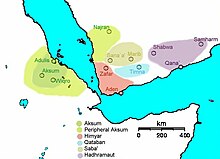Hadramaut (ancient)
Hadramaut ( Old South Arabic : hadramitic ḥḍrmt , Minaic, Qatabanic and Sabaean also ḥḍrmwt ; adjective hadramautic or hadramitic ) was an old South Arabian kingdom in present-day Yemen .
The sources of Hadramaut are worse than that of most of the other old South Arab countries.
history
Nothing is known about the creation of the state. In the 7th century BC BC it went from the supremacy of Ausan to Sabaean hegemony, from which Hadramaut only at the end of the 5th century BC. In alliance with Qataban and Ma'in . The capital of the country was Shabwat , possibly Maifa'at in the early days . In the early days there were particularly close relationships with Ma'in, with whom it was in the 4th century BC. Was even connected by a personal union. Little is known about the period that followed; in the 3rd and 2nd centuries, it was under Qataban's rule since it was defeated by Yada'ib Dhubyan Yuhan'im . How and when it regained independence is unclear, but it is obvious that this, together with the rise of Himyar and the end of Ma'in, around 100 BC. BC, happened.
With the control of Dhofar by the port city of Khor Rori (Sumhuram), the empire ruled from the 5th century BC. The areas of origin of incense and the starting points of the incense route . Since Hadramaut also controlled an important port on the Yemeni south coast with Qana , the country also had a share in the sea trade of South Arabia.
The empire reached its peak in the 2nd century when it succeeded in destroying Timna and conquering Qataban around 150 AD . Despite this success, however, it could not withstand the strong growth in power of its western neighbors Saba and Himyar. In the second half of the 3rd century, Saba conquered the Hadramaut and destroyed Shabwat. Although the country gained shortly after temporarily re-independence, but the kingdom by the incursions was Kinda - Bedouin weakened. With the conquest of Hadramaut by the Sabao-Himyar empire around 340 , the empire finally became extinct.
The kings of Hadramaut
This list essentially follows the research by Kenneth A. Kitchen . The order of the rulers and their dating is sometimes very uncertain. The periods of reign are only given if they are secured by sources.
| Surname | Reign | Remarks | swell |
|---|---|---|---|
| Yada'il | around 685 BC Chr. | Is in deeds report of Sabean Mukarribs Karib'il Watar I mentioned. | |
| Gap in tradition | |||
| Shahr 'Alhan | around 350 BC Chr. | Son of a sumhuyafa | Mentioned only by his nephew Ilsama 'Dhubyan . |
| Yada'il Bayyin I. | Son of Sumhuyafa | two inscriptions | |
| Ilsama 'Dhubyan | Nephew of Shahr 'Alhan | an inscription | |
| Yitha'il | two private inscriptions | ||
| Gap in tradition | |||
| Yada'ib Ghailan | Defeated by Yada'ib Dhubyan Yuhan'im of Qataban | ||
| Part of Qataban, | |||
| Gap in tradition | approx. 180 BC Chr. - 50 AD | ||
| Il'azz Yalit I. | around 30 AD | He or Il'azz Yalit II appears as Eleazos in the Periplus Maris Erythraei | |
| Yada'il I. | Used by Karib'il Bayyin III. called by Saba. | ||
| Yashhur'il Yuhar'ish | In three private inscriptions | ||
| ? | |||
| Yadi'ab Ghailan I , | |||
| Yada'il Bayyin II | around 140/41 AD | Son of Yada'ab Gailan I. | A royal inscription from Shabwat. |
| two unknown rulers? | |||
| Yadi'ab Ghailan II. | around 190 AD | Ally of the 'Alhan Nahfan of Saba | A royal inscription. |
| Yada'il II | Son of Yada'ab Gailan II. | ||
| Il'azz Yalit II. | around 213/4 to about 225 AD | Son of 'Ammdhachar | A royal inscription, various private inscriptions. Received an Indian delegation. |
| unknown rulers | |||
| Yada'il Bayyin III. | Son of Ra'ab'il | A royal inscription | |
| unknown rulers | |||
| Yada'il Bayyin IV. | approx. 250 AD | Three royal inscriptions, private inscriptions. | |
| Yadiʿ'ab Bayyin III. | Brother of Yada'il Bayyin IV. | Private inscription. | |
| Ilrayum Yadum | Son of Yada'il Bayyin IV. | A royal and private inscription. | |
| Yadi'ab Ghailan III. | Son of Yadaʿ'il Bayyin IV. | A royal and private inscription. | |
| Sharah'il | approx. 285-290 | ||
| Rabbschams III. |
Remarks
- ↑ The data in this article refer to Hermann von Wissmann's "Long Chronology"
- ↑ see bibliography
- ↑ M. Arbach, H. as-Saqqaf: Naqsh jadīd min ʿhd Ydʿʾb Yhnʿm malik Qtbn w-Ydʿʾb Ġyln malik Ḥḍrmwt. In: Raydan 7, 2001, pp. 110–123 (Arabic part), figs. 21-22. CSAI number of the inscription: Arbach-Sayun 1 .
literature
- Kenneth A. Kitchen : Documentation for Ancient Arabia. Volume 1: Chronological Framework & historical Sources. Liverpool University Press, Liverpool 1994, ISBN 0-85323-359-4 .
- Andrey Vitalyevich Korotayev : Pre-Islamic Yemen. Socio-political Organization of the Sabaean cultural Area in the 2nd and 3rd centuries AD. Harrassowitz, Wiesbaden 1996 , ISBN 3-447-03679-6 .
- Hermann von Wissmann : On the history and regional studies of old South Arabia. (= Eduard Glaser Collection 3, ZDB -ID 540104-5 = Austrian Academy of Sciences. Philosophical-historical class. Meeting reports, Volume 246). Böhlau, Graz et al. 1964, see especially pp. 198-206, 410.
